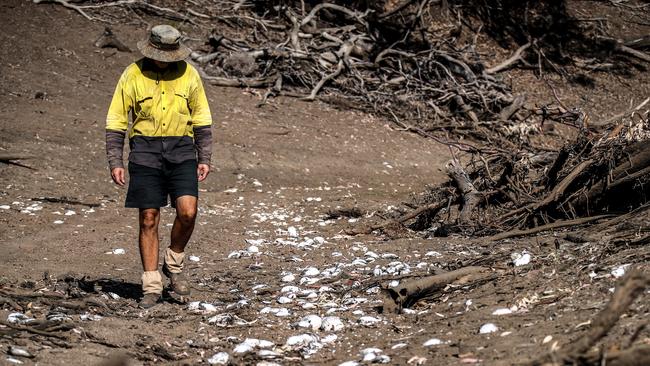Suicide prevention high on drought relief goals
The federal government has defended spending part of $123 million in drought relief on a cemetery toilet block.

The federal government has defended spending part of a $123m tranche of drought relief funding on a cemetery toilet block, music festivals and painting a mural on an old water tank.
Ridiculed by some, Coalition figures privately say the unspoken purpose is to boost morale to keep farmers from taking their own lives. “It can make farmers on the edge step back, rather than you finding them hanging on the end of a rope in a barn,” a government source says.
The Drought Communities Program has run for several years and was recently extended as the declared third arm of the drought package, the other two arms being direct household support for farming families and long-term development of drought resilience. The idea of the program is to keep drought-affected rural communities and the people in them going through financial stimulus to provide jobs through $1m grants to councils.
So far 123 councils have been declared eligible based on criteria of low rainfall and a rural workforce that constitutes at least 17 per cent of the total.
“The DCP has been very successful in stimulating drought-affected communities,” Drought Minister David Littleproud said.
Winton Shire Council, in central western Queensland, received $820,000 to finance the Way Out West Fest, which brought 6000 tourists who strained the seams of a town with a permanent population of less than 1000.
In NSW, Bourke Shire Council spent $25,000 installing new public toilets at the cemetery. Gwydir Shire Council did the same for its cemetery for $36,890, while Dubbo Regional Council outshone them all by spending a quarter of its available grant, $245,000, for public toilets in the city centre.
Also in NSW, Gunnedah Shire Council spent some of its grant on Vietnam War murals and an upgrade of the Lake Keepit Sailing Club. For the dry-as-a-bone Walgett Shire Council in NSW’s far north, its $1m in drought relief money was all about making itself beautiful. The official list of DCP projects says it spent $350,000 on “CBD beautification Walgett”, and another $350,000 on the “Lightning Ridge main street beautification project”, plus $150,000 on the “Collarenebri boat ramp replacement”.
In northern Tasmania, Break O’Day Council spent some money on various walking tracks through the Fingal Valley, providing six jobs for 20 months in an area where work is thin on the ground.
Under grilling from broadcaster Alan Jones as to whether his government was spending enough on drought-ravaged farmers, Scott Morrison raised the CDP program, to which Jones countered, “PM, how does that feed a cow?”
Labor’s agriculture spokesman Joel Fitzgibbon, who has previously said the CDP money seemed to be concentrated in seats held by the Nationals, said: “Labor is absolutely committed to backing every drought effort but when people see public money going to projects of questionable value it further undermines community confidence in the government’s ability to ensure taxpayers’ money is funding meaningful support measures.”
The government defends the “feel good” projects paid for by CDP, such as festivals, on the basis that it maintains morale. “It doesn’t feel that there are tumbleweeds blowing through and the place is dying,” a government source said.
Cropping and livestock farmer Wayne Dunford lives and works on a 1200ha property about 30 minutes out of Parkes in the NSW central west that has been in his family since 1910.
“We won’t harvest a crop for two years in a row now, that hasn’t happened in 110 years here,” the chairman of the NSW Farmers Association Drought Taskforce said.
He has been forced to reduce his livestock by 70 per cent, and spends several hundred thousand dollars a year on bringing in hay to feed remaining sheep and cows.
Mr Dunford says the DCP has injected much-needed funds into local economies, allowing his local Parkes Shire Council to employ a drought response officer, and neighbouring Forbes Shire Council to employ of out-of-work farmers on construction jobs.
“There are farmers who have had to totally shut up their operations, and they have no other way of bringing in income,” he says.
Wentworth Shire Council, on NSW’s border with Victoria and SA, decided to use its $1m to revamp community halls across its 26,000sq km, employing farmers.
Mayor Melisa Hederics says suicide is a growing problem among farmers in her shire. “These people have been working farms that have been in their family for generations. They feel like they’ve failed that legacy, and that causes mental health issues.”
One council project was a kitchen renovation and adding a pool room and verandah to a community hall. We’re trying to do as much as we can to give these farmers something to do,” says Hederics. “The halls are a place to meet with other farmers.’’



To join the conversation, please log in. Don't have an account? Register
Join the conversation, you are commenting as Logout